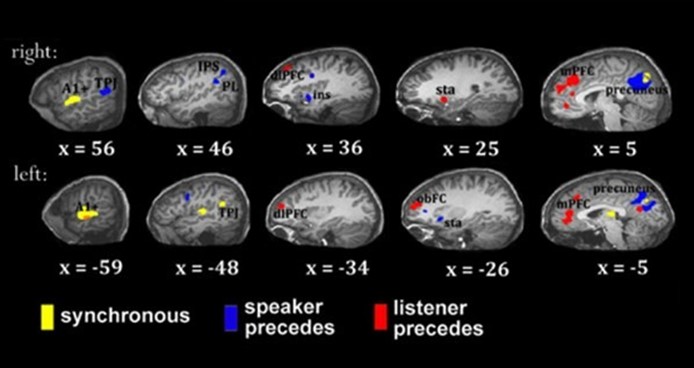The Science Behind Connecting Through Storytelling
3 min read.
People may forget what you said, but they will never forget how you made them feel. Which is why the use of memorable and emotive storytelling is crucial to the success of any employer brand. But there is a science behind it...
The MRI scan above is a snapshot of the research undertaken by Greg Stephens and Uri Hasson. The scan shows evidence of the ways in which our minds 'sync' when storyteller and listener are engaged with one another. This MRI quantifies the experiences we have when we form deep emotional connections with stories. It proves the link between storytelling and engagement.
When it comes to loyalty towards brands, studies have shown our emotional response to a brand has a greater influence on our loyalty towards them - moreso than logic and other judgements. We evaluate brands primarily with our emotions first.
We feel first and think second.
So what does that mean for employer brand marketers?
It means we need to think about how we make people feel, through harnessing the power of emotion. How do we create experiences and feelings that resonate with our target personas in our efforts to forge connections?
The good news for great storytellers (in this case, you and your business), is that we are hardwired to listen, take in and remember stories as opposed to remembering facts and figures over time or long periods.
With this in mind, here's some tips to help you connect with your customers through the science of storytelling:
Firstly, understand your target persona:
- Who are they? What’s their background?
- What are their characteristics?
- What pains and problems are they looking to solve in both their professional and personal lives? What are they measured on?
- How you can you create stories that offer education and information that will help them overcome their challenges?
Lead with empathy, put the spotlight on your customers and understand them before you create stories to 'get on their wavelength' and for them to match yours.
In all of my research into this subject over the last few years I have found that there are five crucial emotive states that help to 'light up' our brains:
Happiness: When we see something funny that creates a sense of joy and amusement - we feel happy and feel an urge to 'share' how we feel
Sadness: When we feel sad, we feel compelled to bond and talk about how we feel
Fear: When we are scared, our hearts begin to race, adrenaline begins to flow and the fight or flight mode kicks in, spurring us into action
Anger: This can elicit a response or compel people to form an opinion and challenge what is being said
Anticipation: Humans are hardwired to crave the outcome of what happens next. Who hasn’t binged episode after episode of a Netflix series?
Consider how to use these emotions to help you engage with your audience. Human chemistry will release chemicals that will create emotional drivers that really forge a connection with your audience.
Remember to always be authentic, sincere and genuine
We've all seen the 'staged' corporate videos. And we don't believe them, because they’re staged! In NLP (Neuro Linguistic Programming) this is known as the critical faculty - or what you might also call, our 'bullshit detectors'.
As humans we train our brains to screen out rubbish. The average attention span is now six seconds... Even a gold fish has more!
Make sure you do everything to tell the truth - we are designed to 'seek the truth' and avoid the bullshit.
Don't be afraid to tell stories through your people. Use people who reflect the target personas that you want to connect with. Helping them empathise will provide familiarity to your audience.
Build trust and credibility
We need to lead with empathy and plan how we use emotion in our marketing. Once we’ve achieved this, we must also build trust and confidence through facts and figures.
Data helps to provide evidence and confirm to our brains that we are making the right choice. Consider how you can be creative in how you represent and 'show off' facts and figures - don't just 'write' it. Consider visual assets, interactive 'widgets' and videos.
This will help you to connect both emotionally and rationally with your audience.
Involve the customer in your stories
By involving your customers in building and keeping your stories alive, you will harness the power of community. Seek and build trust through inviting your customer to be part of your brand stories and the work that you do. You'll be providing social proof - not selling through yourself.
When you say it, it's selling. When they say it, it's social proof.
Google loves user generated content. This is a great way to bring unique, valuable and engaging content through the power of your communities and raise your page ranking too.
What's more, when we tell stories it's proven to make our brains release oxytocin - the chemical that helps to build trust and empathy, thereby helping to connect with the people in the story and helping to feel the context around it.
Never forget that you are fighting for attention, amongst so many other voices. Our brains want to idle most of the time, so when telling stories, yours needs to grab attention and resonate with your audience immediately.




